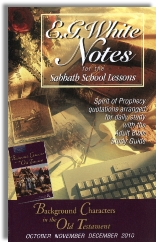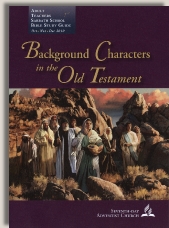|
||||||||||||||
Commentary on the introduction: "Background Characters in the Old Testament"
Background Characters
The Sabbath School Quarterly for the fourth quarter is a study of various characters in the Old Testament. The title of the Quarterly refers to these individuals as “background characters” and refers to them on page 3 of the Introduction (in the Teacher’s Quarterly) as “supporting cast.” Although each of these individuals were significant in certain ways to the Old Testament history of Israel, they could not truly be said to be supporting cast, while other characters in the Old Testament (or New for that matter) are the “supported” cast.
In the history of the world, there are two parties: God and his creation. Every individual whom God has created are his supporting cast. No one in history, no matter how “important” they may seem to fallen human beings, holds a position in God’s eyes any higher or more important than others. One excellent way to look at this fact is to review the detailed history of each person listed in Hebrews chapter 11. This chapter is the so called “Faith Hall of Fame.” Upon doing this, one soon finds that even the more prominent individuals used by God were there for the specific purpose of supporting his divine plan and purpose.
God had plans and God made promises. Each individual in the Old Testament history was used of God to perform the role or function that he had planned. We do not participate with God, in the sense of helping him complete what he has planned from all eternity. We, and these characters from the Old Testament, are blessed to be a part of the story (His-story) that God is telling in his word.
Shadow Figures
The title of the introduction to this quarters lessons on page 2 of the Teacher’s Quarterly is "Shadow Figures." I find it interesting that a Church that has mistaken Old Testament shadows (such as the Sabbath) for realities in the person of Jesus would refer to historical figures as “shadow figures.” One wonders what may be meant by this phrase, but we are only told that these are those who “existed in the background, the ones easily overlooked and forgotten.” Yes, from a human standing these people weren’t prominent. The Bible is God’s story – not man’s. It is the story of humanity, told by God from two perspectives; the earthly and the heavenly.
The authors of these lessons appear to have taken a lesson from Dr. Bruce Wilkinson, the author of the bestseller, The Prayer of Jabez. In that small book, Wilkinson has taken a character about whom not much is known and woven much speculation, some of it Biblically supported, to create a work that has revolutionized the prayer lives of many.
Each individual in God’s story has played a significant role. The lesson authors state,
In the end, however, these “minor” characters made it into God’s master story, and from their stories we can learn things that can help us to write a different and better story for ourselves.
Either we are going to be a part of God’s story or we are not. If we are going to participate in God’s story, we had better be certain that we are not attempting to “write a different and better story for ourselves.” It would be atrocious to determine that our story (our life and life-experiences) is so bad that we must “write a different and better” story. There are those in life who have learned that, whether homeless, diseased, in war, poverty, or even comatose, they can participate in significant ways in the story that God has told in the Old Testament, and has continued to tell in the final revelation of his son, Jesus Christ.
Do we truly want to write a “different” or “better” story than what God has written?
The Seventh-day Adventist Church has become expert at the shadows. Creation, the sanctuary, the Sabbath, the Law, clean and unclean foods, tithe and a host of other components of the Old Covenant (Testament) that foreshadowed Christ are still central. If they were not central, they would only be mentioned occasionally, rather than frequently as they still are. In reality, the Adventist Church, as an organization is easily categorized with some other questionable religious organizations. This is not from those outside, but inside the organization. On page 5 of the Spring 2010 issue of the Walla Walla University magazine, Westwind, we find the following statement:
The Seventh-day Adventist Church is one of the four most innovative denominations founded in the United States in the 19th century, along with the Church of Jesus Christ of Latter-day Saints (LDS); the Church of Christ, Scientist; and the Jehovah’s Witnesses. Currently, the Adventist church has the largest worldwide membership of the four.1
Any orthodox Christian student of religious history in the United States would never refer to three of those groups as “denominations.” The Mormons, Christian Scientists and Jehovah’s Witnesses are all considered members of cults. Also, anyone familiar with the theology of these groups or historical theology would never refer to these groups as “innovative.” The teachings of these groups are simply resurrected theologies from centuries and millennia past that the Christian Church has dealt with scripturally and decisively.
Shadows or Reality?
What are shadows and what are important parts of the story that God has been telling in the Old Testament and is now telling through his son Jesus must be understood. To confuse shadows with reality or to relegate historical figures to the shadows is to mishandle the word of God.
Finally, in learning about these Old Testament characters and the roles they played in the story of God as told in his word; let us learn how we become parts of this story and what role(s) we can play. The lesson authors state that, “…we can become part of the great story of salvation, even if we might not be the main characters in the grander scheme of the cosmic drama that unfolds around us.”
God forbid. We must never think that we can become a part of the great story of salvation. That story begins and ends in the person of Jesus Christ. The “cosmic drama” that has unfolded began in the Garden of Eden and ended the morning of the resurrection of Jesus nearly 2,000 years ago. Even as we are saved by the blood of Jesus shed on the cross we do not become part of that story, we simply are provided an opportunity to share the story of him who has saved us with those yet needing his forgiveness and redemption.
The story of Jesus begins in Genesis 3:15. He is the one who will crush the serpents head. His story ends in Revelation 22:21-21 where we read:
He who testifies to these things says, Surely I am coming soon. Amen. Come, Lord Jesus! The grace of the Lord Jesus be with all. Amen. (ESV)
May we all walk in the light as Jesus is in the light, and not become partakers of those who dwell in shadows, nor of those who cannot discern between shadow and reality. If you’re having trouble in any of these areas, we here at Bible Studies for Adventists have much good news to share with you and frequently pray for you. If you would like, please contact us. We would love to hear from you.
This quarter, let’s not try to write a different or better story than what God has written. Let us truly be a part of the greatest story ever written. †
1. Westwind, The Journal of Walla Walla University, Spring 2010, p. 5, article titled, “Historical Perspectives, Professor Teams With Historians for Ellen G. White Research Project”.
Unless otherwise indicated, all scripture quotations are from The Holy Bible, English Standard Version® (ESV®), copyright © 2001 by Crossway, a publishing ministry of Good News Publishers. Used by permission. All rights reserved.”
Copyright 2010 BibleStudiesForAdventists.com. All rights reserved. Revised September 23, 2010. This website is published by Life Assurance Ministries, Glendale, Arizona, USA, the publisher of Proclamation! Magazine. Contact email: BibleStudiesForAdventists@gmail.com.
The Sabbath School Bible Study Guide and the corresponding E.G. White Notes are published by Pacific Press Publishing Association, which is owned and operated by the Seventh-day Adventist church. The current quarter's editions are pictured above.
Official Adventist Resources
Standard Edition Study Guide Introduction
Teacher's Edition Study Guide Introduction


